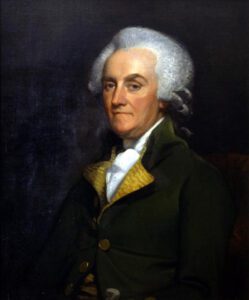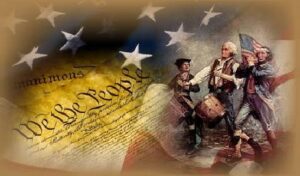Research as recent as 2000 has determined at the outbreak of the American Revolutionary War British Loyalists made up 15-20 percent of the total colonial population. This would seem to be a large “Fifth Column” that could rise up and join the British to defeat the revolutionaries. Prominent loyalists had in fact assured the British that most loyalists would spring to arms and fight for the Crown and the British planned accordingly. Fortunately for the Continental cause this threat never materialized with only a few thousand loyalists taking up arms. Many loyalists avoided the whole situation by leaving the American colonies. Those that remained faced economic and physical abuse so most kept a low profile hoping to weather the storm unscathed.
The number of loyalists did, however, reduce the population that the revolutionaries could count on for support. At the start of the war the free white population of the colonies is estimated to have been 2.25 million , which means there were at least 400,000 to 450,000 loyalists. Revolutionaries could at most claim only about 50 percent active popular support. Consequently, they could only rely on between one million and 1.8 million people to supply all types of support, including soldiers. Odds makers would not have predicted a successful revolution.
Historically during wars, particularly civil wars and revolutions, the population’s loyalties are divided. This often leads to terrible atrocities during hostilities and to retribution once hostilities have ended. Every war and revolution in my lifetime have experienced these problems. One thing we and others have learned the hard way is that lasting military success is unlikely if you don’t have the population’s support. Chinese revolutionary Mao Tse Tung wrote: “The guerrilla must move amongst the people as a fish swims in the sea.”
Loyalists were referred to as Tories, Royalists, and King’s Men and the revolutionaries were known as patriots. Officially, patriots referred to loyalists as “persons inimical to the liberties of America.” Loyalists came from a broad spectrum of colonists but tended to be older, and well established with strong emotional and economic ties to Britain. They feared and loathed what they saw as mob rule and chaos. Loyalists certainly were not trusted by the patriots, and the British were a little suspicious of them too. The British military did provide active protection for loyalists in areas they occupied.

Conflicting loyalties bitterly tore many families apart. The most famous was the Benjamin Franklin family. Ben’s illegitimate son, William, was the Royal Governor of New Jersey and was a vocal loyalist. William was imprisoned by the patriots and not released until 1778. He then tried to organize loyalist military units, but with little success. After the war, William fled to England and chose to be permanently estranged from Ben.
The highest concentration of loyalists was in the middle colonies: tenant farmers, Dutch, and Anglicans in New York, New Jersey, and Connecticut; and Germans and Quakers in Pennsylvania. To the south the Highland Scots in the Carolinas and Presbyterians farther south. In addition, most of the Iroquois Indian tribe joined the British. New York City and Long Island were occupied by the British from 1776 to 1783 so that area contained the largest concentration of loyalists. Many of these were refugees from other states.
The British were forced out of Boston by March 1776, but they gained control of New York City and Long Island. They also controlled the Hudson River and rapidly seized control of Philadelphia, Pennsylvania; Savannah, Georgia; and Charleston, South Carolina. Fortunately for the Patriots, about 90 percent of the colonial population lived outside the cities. By 4 July 1776, Patriots had gained control of most of this territory and had expelled all royal officials. No one who openly proclaimed allegiance to the Crown was allowed to stay so many loyalists fled to British controlled areas or kept a very low profile. The British did manage to re-establish a Loyalist government in coastal Georgia from 1779 to 1782 despite patriot control of northern Georgia.
In 1775 the Royal Governor of Virginia, Lord Dunmore offered freedom to indentured servants and slaves if they would bear arms for the Crown. Eventually about 12,000 blacks honorably served in British units. Following the war about 4,000 of these black soldiers migrated to Nova Scotia and New Brunswick in Canada where many white loyalists also settled. Life was not easy for these blacks because the promised Canadian land grants came slowly and because they were harassed by the white loyalists.
In 1791 black loyalists were offered transport to the colony of Sierra Leone in West Africa with a promise of better land and equality. About 1,200 left Nova Scotia and settled in Sierra Leone where they soon became the ruling elite.
Between 400 and 1,000 black loyalists migrated to London after the war joining a free black community of about 10,000.
Free Blacks had served in some colonial state militias prior to the Revolutionary War, and they were mustered into Continental service with their units. Many were combat veterans having fought in the French and Indian War. After considerable foot-dragging, the patriots finally began recruiting free blacks and offering freedom to slaves who would serve in the Continental Army. There are no firm numbers on the total number of blacks in the Continental Army and Navy during the war but estimates put the number at about 9,000. We do know that blacks fought valiantly next to their white counterparts. Unfortunately, many of the promises of freedom were not honored after the war and many blacks were returned to slavery.
The Continental Army and Navy were totally integrated during the Revolutionary War, but the Federal Militia Act of 1792 again denied military service to blacks. This would not be officially changed until the 1950’s when President Truman began the integration of the military by first eliminating all-black units.
The plight of loyalist women whose husbands or fathers had joined British military is often overlooked. They were left to protect their property from patriot hostility during the war without any male support. When the war ended most of their men fled to the safety of England leaving the women to fend for themselves. The main punishment for loyalists was the expropriation of property, but married women were protected since they had no legal rights except through their husbands (“feme covert”). This meant if the patriots confiscated the property of the wives, they were punishing the women for the crimes of their husbands. This moral and legal dilemma was usually ignored, and the property of most loyalist women was summarily confiscated.
Canada remained loyal to the Crown despite patriot efforts to recruit them to join the Revolution. Some did join the patriots, and some joined the British, but the numbers were not significant and had no impact on military outcomes. English settlers in Canada were mostly recent immigrants and were not interested in revolution. The older British colonists in Newfoundland and Nova Scotia remained loyal making support of the patriot cause illegal, and they took in many fleeing American loyalists. The French in Quebec were happy with British rule and did not want to ally themselves with their historical enemies, the Protestants.
The Continental Army moved against Quebec in 1775 attempting to move the Canadian border farther north away from the New England Colonies. They captured Montreal in November but were repelled at Quebec City the next month. The Continentals were completely driven out of Quebec in the spring of 1776. There would be no further serious attempts to challenge the British in Canada until the War of 1812.

Quebec was used as a base for raids by loyalists and Indians against American frontier communities. These communities were inhabited mostly by women, children, old people, and young boys for defense. A raid by loyalists and Iroquois Indians in July 1778, known as the Wyoming Massacre, resulted in the killing of at least 350 American settlers in the Wyoming Valley of Pennsylvania. Such bloody raids against civilians led to retaliation against the Iroquois after the war.

As previously noted, during the war many of the hated loyalists were subjected to confiscation of their property, public humiliation such as tarring and feathering, and physical attack. Much of this was to warn others to keep quiet and to not organize against the patriots. Two residents of Philadelphia who aided the British during the occupation of that city were tried for treason and executed.
No matter how much the civilian Loyalists were hated, it was those who actually served in the British military that earned the most vengeance. When captured by the Continental forces they were treated as traitors rather than prisoners of war. George Washington detested them saying in 1776 that “they were even higher and more insulting in their opposition than the regulars.”
Once hostilities ended the states established committees to confiscate loyalist property. Personal paybacks were common and were often very violent. Despite this, most loyalists stayed in the new nation. These loyalists tended to have strong and stable family and economic ties to the country.
Large numbers of Iroquois and other Native Americans were expelled from the country because of their active support of the British by conducting bloody raids on the frontier. Most settled in Canada where their descendants still live.

About 60,000 Loyalists (including about 10,000 blacks) left the country. Most went to Canada where there were offers of land and compensation, but they also fled to Florida and the Caribbean Islands. About 13,000 (including about 5,000 blacks) went to Britain which also offered aid. The British exiles included many of the wealthiest and most prominent who were looking to rebuild their careers. Southern loyalists mainly migrated to areas where slavery was legal so they could take their slaves to reestablish large scale farming.
The loss of 60,000 residents, particularly those who were successful merchants and landed gentry, had some immediate negative effect on the US economy but it was short-lived because of rapid national expansion and economic development.
Public sentiment against loyalists died down significantly after the government was formed under the Constitution of the United States in 1789. Most of the early punishment and hatred of loyalists had spent itself and people turned their attention to building and expanding the country. Immigration into the country exploded and borders were being pushed westward. Opportunity was everywhere and most people wanted a piece of the action.
The concepts in the Constitution were becoming reality by the establishment of our unique government. To “help” with the development and function of the government, national political parties were established. Former loyalists were courted by the parties and became equal partners in the political development of the country.
Legally, most state laws against loyalists were repealed by 1787. Later, The War of 1812 resulted in the total ejection of the British presence in US territory and confirmed American borders. This war also served as a catalyst that brought Americans together as one united people, and the few remaining laws against former loyalists were rescinded.

Despite the initial intense hatred between loyalists and patriots, the people eventually assimilated all political beliefs and became one people, Americans. This ability to absorb different nationalities, ideas, and races is uniquely American and is one of the great strengths of our country. Americans are proud of their ethnic heritages but are not ruled nor identified by them. We are all: “We the people of the United States of America.” We do not intend to ever allow this to change.
